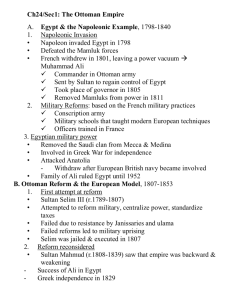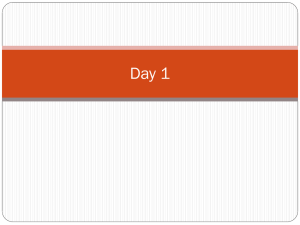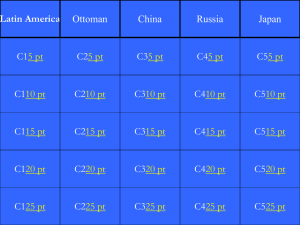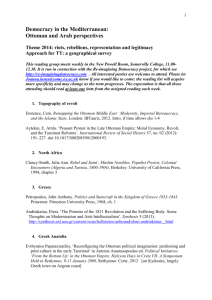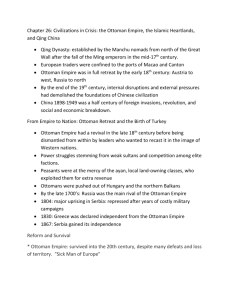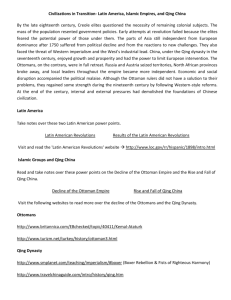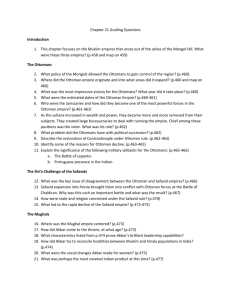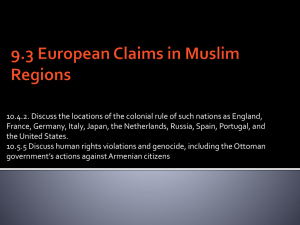Chapter 26 Reading Guide Civilizations in Crisis: The Ottoman
advertisement
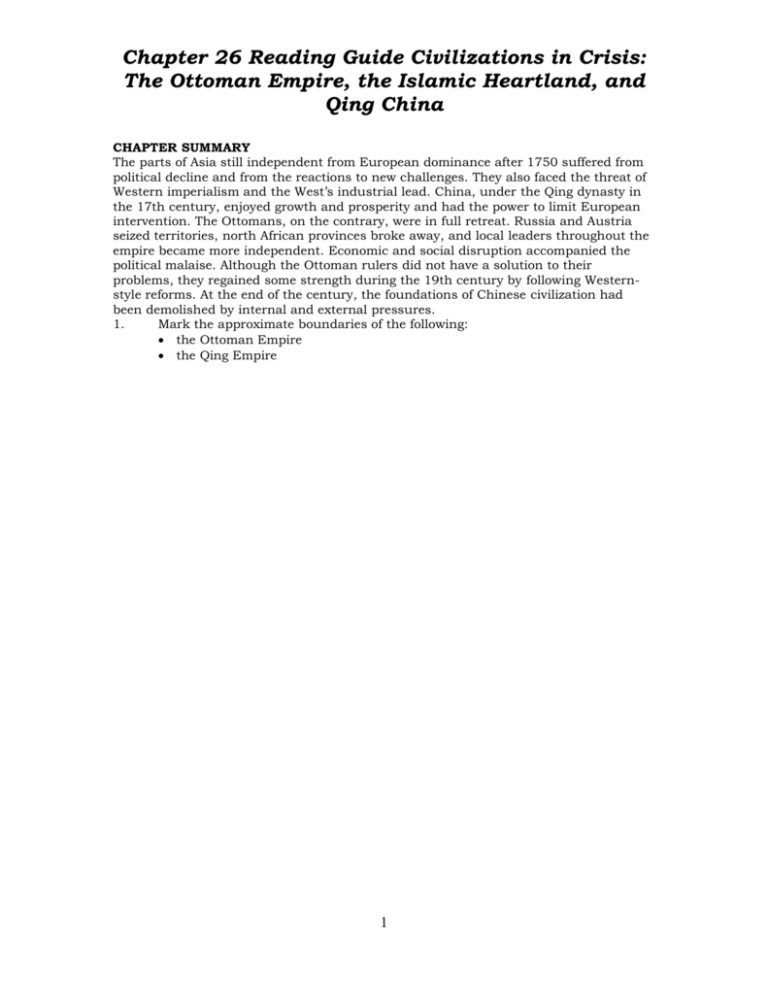
Chapter 26 Reading Guide Civilizations in Crisis: The Ottoman Empire, the Islamic Heartland, and Qing China CHAPTER SUMMARY The parts of Asia still independent from European dominance after 1750 suffered from political decline and from the reactions to new challenges. They also faced the threat of Western imperialism and the West’s industrial lead. China, under the Qing dynasty in the 17th century, enjoyed growth and prosperity and had the power to limit European intervention. The Ottomans, on the contrary, were in full retreat. Russia and Austria seized territories, north African provinces broke away, and local leaders throughout the empire became more independent. Economic and social disruption accompanied the political malaise. Although the Ottoman rulers did not have a solution to their problems, they regained some strength during the 19th century by following Westernstyle reforms. At the end of the century, the foundations of Chinese civilization had been demolished by internal and external pressures. 1. Mark the approximate boundaries of the following: the Ottoman Empire the Qing Empire 1 Chapter 26 Reading Guide Civilizations in Crisis: The Ottoman Empire, the Islamic Heartland, and Qing China 2. Look at the map from Chapter 22. Which of the two declining empires was closest to the European imperial interests in the Asian trade network? Does this help explain the more direct incursion of Europeans in one civilization than in the other? (HINT: you probably can’t answer this until you read the chapter) 3. What was Hong Xiuquoan’s movement called? 4. What did targets did his movement single out for retribution? 5. How does Hong’s background explain the choice of targets for his movement? 6. Why would his movement proclaim that women were equal to men? (HINT: see question 5 above) 7. List several reasons why European powers were unable to colonize China and the Ottoman Empire. 2 Chapter 26 Reading Guide Civilizations in Crisis: The Ottoman Empire, the Islamic Heartland, and Qing China FROM EMPIRE TO NATION: OTTOMAN RETREAT AND THE BIRTH OF TURKEY. 8. How did the Industrial Revolution, commercialization, and the West contribute to the decline of the Ottoman Empire? 9. How did Russia increase its power prior to striking at the Ottoman Empire? 10. Your text states that the Russians advanced towards the “warm-water ports” on the Black Sea, controlled by the Ottomans. What do you think “warm-water ports” are and why did Russia so desperately need them? 11. How did Ottoman alliances with Christian powers reveal weakness? REFORM AND SURVIVAL. 12. Why didn’t one European power, for example Russia, simply take out the Ottoman Empire if it was so weak, esp. considering the religious differences (Muslim vs. Christian)? 13. What European power propped up the Ottoman Empire? 14. Why did that power help the Ottomans? 15. How did Mahmud II prove that he’d learned from the mistakes of Selim III? 16. What MAJOR departure from past practices regarding the West did the Ottomans make during the 19th century? 17. In Chapter 25 we learned that Britain saved the Portuguese royal family from Napoleon and escorted them to Brazil FOR A PRICE. Britain exacted the same price from the Ottomans. What was this price, why did Britain want this, and how did it affect Ottoman producers? 18. What Western ideas did not elicit change in the Ottoman Empire? 3 Chapter 26 Reading Guide Civilizations in Crisis: The Ottoman Empire, the Islamic Heartland, and Qing China REPRESSION AND REVOLT. 19. We’ve read about this before in India and Africa. The West comes in, educates a group of indigenous people, and then what happens? 20. How did the last Ottoman Sultan respond to results of Western education? 21. What European country began to supplant Britain as an aide to the Ottoman Empire? 22. When did the last Ottoman Sultan meet his end and at the hands of who? 23. What European country took the Ottoman’s last possession in North Africa and why is it logical that it targeted that part of North Africa? (HINT: look at a map of the countries involved if you must) 24. Describe the relationship between Arabs in the Ottoman Empire and the Turks who controlled the government in the early 20th century. IN DEPTH: WESTERN DOMINANCE AND THE DECLINE OF CIVILIZATION. 25. What internal factors contributed to the decline of past civilizations? 26. What external factor did many fallen civilizations share? 27. In what area could Africa and Asia NOT stand up to the Europeans in the 15 th and 16th centuries? 28. What allowed Europe to dominate Africa and Asia on the land in the 18th century? 29. It seemed like the West was going to take over the world. Your text implies (probably correctly) that one event threw a wrench into that plan. What was it? 4 Chapter 26 Reading Guide Civilizations in Crisis: The Ottoman Empire, the Islamic Heartland, and Qing China WESTERN INTRUSIONS AND THE CRISIS IN THE ARAB ISLAMIC HEARTLANDS. 30. What were the two main options proposed by Islamic thinkers to deal with European expansion? MUHAMMAD ALI AND THE FAILURE OF WESTERNIZATION IN EGYPT. 31. What was Napoleon’s objective by invading Egypt? 32. What effect did the Mamluks’ defeat have on the Muslim world? 33. Who saved Egypt from French domination? 34. Who took over in Egypt after Napoleon was forced out and where was he from? 35. How did this individual try to transform Egypt? 36. In a sense, Europe didn’t need to colonize Egypt. Why? (HINT: think about why Europe colonized other parts of the world and look at what Egypt started doing to increase its wealth) BANKRUPTCY, EUROPEAN INTERVENTION, AND STRATEGIES OF RESISTANCE. 37. Why did Egypt become such a strategically valuable country in the 19th and 20th centuries? 38. What two bodies of water were connected by the canal and how did this benefit Europe, esp. Britain? (HINT: captions are your friend) 39. What side of the Islamic debate over how to deal with European encroachment do you think Orabi was probably on? (HINT: pay attention to his background) 40. What European country came to dominate Egypt following the defeat of Orabi? 5 Chapter 26 Reading Guide Civilizations in Crisis: The Ottoman Empire, the Islamic Heartland, and Qing China JIHAD: THE MAHDIST REVOLT IN THE SUDAN. 41. What trade did the Egyptians seek to end and how did this cause them trouble? 42. What was the source of Muhammad Achmad’s power? 43. On what side of the Islamic debate on how to deal with growing European power did Achmad and his Mahdists fall on? 44. Who put an end to the Mahdists once and for all? VISUALIZING THE PAST: MAPPING THE DECLINE OF CIVILIZATIONS 45. List the continents on which the Ottoman Empire held territory. 46. Explain: which of two empires, Ottoman or Qing, was harder to defend? 47. What occurs in Manchuria over time? 48. What European power dominated Indochina? 49. How is Japan like a European power? THE LAST DYNASTY: THE RISE AND FALL OF THE QING EMPIRE IN CHINA. 50. Interpret the cartoon below in terms of Chinese history by annotating it with the appropriate names and explain the mistake that was made. 6 Chapter 26 Reading Guide Civilizations in Crisis: The Ottoman Empire, the Islamic Heartland, and Qing China 51. Compare Qing/Manchu rule to Mongol/Yuan rule. (Don’t list everything. 2 or 3 similarities/differences will do.) ECONOMY AND SOCIETY IN THE EARLY CENTURIES OF QING RULE. 52. What changed more under the Qing, the economy or society? Explain. ROT FROM WITHIN: BUREAUCRATIC BREAKDOWN AND SOCIAL DISINTEGRATION. 53. This section is titled “Rot from Within”. List several examples of “rot” that brought about the decline of the Qing Dynasy. 54. Interestingly, your text implies that Chinese thinkers became complacent at the end of the Qing Dynasty, assuming that the Mandate of Heaven and the usual pattern of dynastic cycles would run its course and things would work out. What new factor(s) had been introduced that those thinkers were not taking into account? BARBARIANS AT THE SOUTHERN GATES: THE OPIUM WAR AND AFTER. 55. Who were the new barbarians at the gates of China? 7 Chapter 26 Reading Guide Civilizations in Crisis: The Ottoman Empire, the Islamic Heartland, and Qing China 56. How were these new barbarians different from those of the past? 57. Write a caption for the following cartoon based on information in this section. 58. What key port did the British acquire in this war (which was returned to China on July 1, 1997)? A CIVILIZATION AT RISK: REBELLION AND FAILED REFORMS. 59. Why did the Taiping Rebellion stall? 60. What power did the Qing fight a losing war with in 1894-95? 61. What was the general Qing response to reform efforts? 62. What was the aim of the Boxer Rebellion and what was its impact on China? 8 Chapter 26 Reading Guide Civilizations in Crisis: The Ottoman Empire, the Islamic Heartland, and Qing China THE FALL OF THE QING: THE END OF A CIVILIZATION? 63. How did Western education once again play a revolutionary role? 64. On what date did the LAST Chinese emperor step down? Name the emperor. 65. What happened in 1905 that ended a 2500 year tradition? DOCUMENT – BUILDING A NEW CHINA 66. What is single most important change that China has to make before it can implement other changes, according to Qichao? GLOBAL CONNECTIONS: MUSLIM AND CHINESE DECLINE AND A SHIFTING GLOBAL BALANCE. 67. Here’s an irony: your text states that contact, both peaceful and hostile, with the West actually helped Muslim civilization survive Western challenges while Chinese civilization did not. Explain 9

